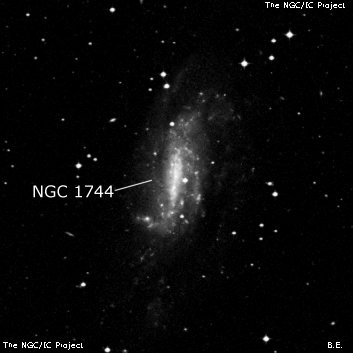
John Herschel discovered NGC 1744 = h2692 and called "vF, vL, vmE, vgvlbM, 4' long, 2.5' broad." His position is ~35 sec of RA too far east, but the identification is certain based on the description.
Joseph Turner sketched this galaxy on 11 Dec 1876 using the 48" Great Melbourne Telescope (plate III, figure 23 at www.docdb.net/history/texts/1885osngmt________e/lithograph_m_3_23.php). He found the nebula much elongated ~N-S, length about 2' 20" and much fainter than expected. Herbert Howe measured an accurate position in 1898 using the 20" refractor at Chamberlin Observatory (repeated in the IC 2 notes).
300/350mm - 13.1" (1/18/85): weak central brightening. A faint double star at 20" separation is at the north edge.
13.1" (12/22/84): fairly faint, fairly large, very diffuse, elongated 5:2 ~N-S, 5'x2', fairly even surface brightness. Two mag 14 stars are at the north edge 2.5' from the center with a total of three or four faint stars superimposed.
Notes by Steve Gottlieb